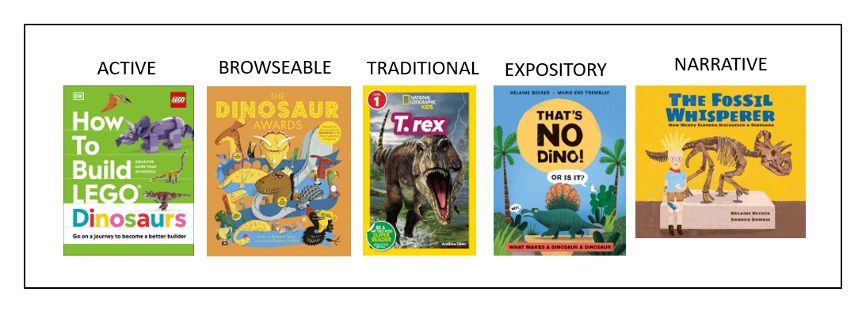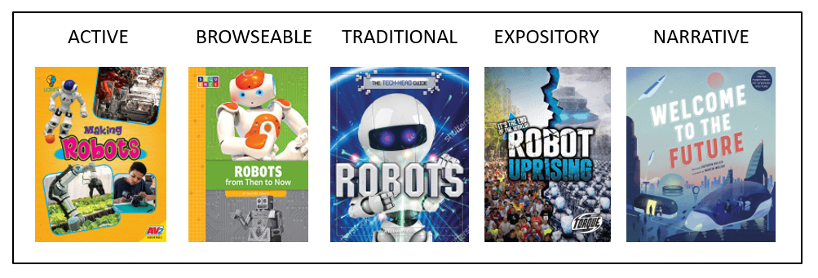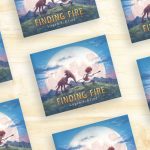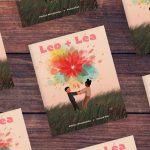What percentage of your classroom library collection is nonfiction? When I proposed this question to myself , I realized that my classroom library collection had roughly less than 20% nonfiction books and of that selection many were narrative nonfiction. A large reason for this was because I had amassed my collection from hand outs and garage sales, so even having books to fill a classroom library was a feat as a new teacher. Additionally, my personal preference for fiction and my belief at the time that most students enjoyed fiction over nonfiction played a part in any newer books I was adding to my collection. In 2021, I read the newly published professional text 5 Kinds of Nonfiction by Melissa Sewart. In this text, I learned a lot more about nonfiction readers and that many of those readers can be more drawn to facts and figures rather than narrative nonfiction or a fiction story structure. In the beginning of 5 Kinds of Nonfiction, Stewart supports that learning by stating a result of a study noting, “42% of students preferred expository nonfiction, 25 % preferred narrative nonfiction, and 33% enjoyed both in a study published in 2017 by Repaskey, Schumm, and Johnson” (Stewart and Correia, 2022, 27). When I reflected on these statistics and what that meant for my past students, I wish I had provided more options for my nonfiction lovers who had me as a teacher because my classroom library was really lacking in nonfiction options. Thankfully I routinely took my students to the library, so I feel I was partially redeemed with that action to at least have given those readers access to the more robust nonfiction collection that the library had to offer. Like many new teachers, I had to fully fund my classroom library, and I bought books that brought me joy which were almost exclusively fiction. In hindsight, I would have surveyed my students and discovered their interests to help guide my purchases as well as found other funding sources to help off-set my out-of-pocket cost towards books.
Melissa Stewart presents five kinds of nonfiction as a way to identify the different types of nonfiction available for students. Those categories are as follows: Active, Browseable, Traditional, Expository, and Narrative . Focusing on selecting nonfiction from all of the five categories can help diversify and balance your nonfiction collection. I remember loving the Guiness Book of World Records series books when I was in grade school and also how those books were fought over because of their popularity and because they were really the only other type of nonfiction title beyond traditional texts. “Experts recommend a fifty-fifty mix of fiction and nonfiction (Dreher and Kletzein 2015), with at least two-thirds of the nonfiction having an expository writing style” (Stewart and Correia, 2022,37).
Today we are fortunate that authors and publishers are creating high-interest nonfiction in all categories to appeal to readers. Below are the characteristics that describe each kind of nonfiction. These characteristics can help guide you in understanding how to choose books from each of the five kinds of nonfiction to grow and diversify your nonfiction collection .
Active– Highly interactive and/or teaches skills for engaging in an activity, how-to guides, field guides, cookbooks, craft books, clear, straightforward language, expository writing style
Browseable– Eye-catching design, lavishly illustrated, short blocks of straightforward text, can be read cover to cover or by skipping around, great for shared reading, expository writing style, description text structure
Traditional– Survey (all-about) books, overview of a topic, often part of a large series, clear, straightforward language, expository writing style, description text structure
Expository – Focused topics presented creatively, strong voice and rich, engaging language, innovative format, carefully chosen text structure, expository writing style, books about specialized ideas, such as STEM concepts
Narrative– Narrative writing style, tells a story or conveys an experience, real characters, scenes, dialogue, narrative arc, strong voice and rich, engaging language, chronological sequence structure, books about people (biographies), events, or processes
(Stewart and Correia, 2022, 12-19)
Using the characteristics of the five kinds of nonfiction, I have selected examples of each type of book based on a popular theme for elementary students.
Dinosaurs

Sports

Robots

Sharks

Inventors/Inventions

Bibliography:
Girls Think of Everything: Stories of Ingenious Inventions By Women by Thimmesh, Catherine
Great Basketball Debates by Ybarra, Andres
Great White Sharks by Auss, Hilary
Groundbreaking Scientists by Miller, J. P.
How to Build Lego Dinosaurs by Farrell, Jessica
How to Spy on a Shark by Houran, Lori Haskins
Inventors and Inventions by Brundle, Joanna
Making Robots by Bow, James
My Life As a Great White Shark by Sazaklis, John
Robot Uprising by Owings, Lisa
Robots by Potter, William
Robots From Then to Now by Grack, Rachel
The Shark Book by Jenkins, Steve
Sports Stadium: In 10 Simple Steps by Mason, Paul
Swish!: The Slam-Dunking, Alley-Ooping, High-Flying Harlem Globetrotters by Slade, Suzanne
Rex by Silen, Andrea
That’s No Dino!: Or Is It?: What Makes a Dinosaur a Dinosaur by Becker, Helaine
This Book Thinks You’re An Inventor by Milton, Jon
Welcome to the Future by Hulick, Kathryn
References:
Stewart, Melissa, and Marlene P. Correia. 5 Kinds of Nonfiction: Enriching Reading and Writing Instruction with Children’s Books. Hawker Brownlow Education, 2022.






